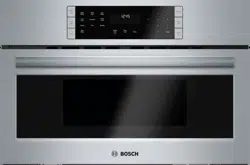Documents: Go to download!
User Manual
- User Manual - (English, French, Spanish)
- installation manual - (English)
- Getting to know the appliance
- Before using the appliance for the first time
- Microwave
- Cleaning and Maintenance
- Troubleshooting
Table of contents
Use and Care Manual Oven
Getting to know the appliance
Parts
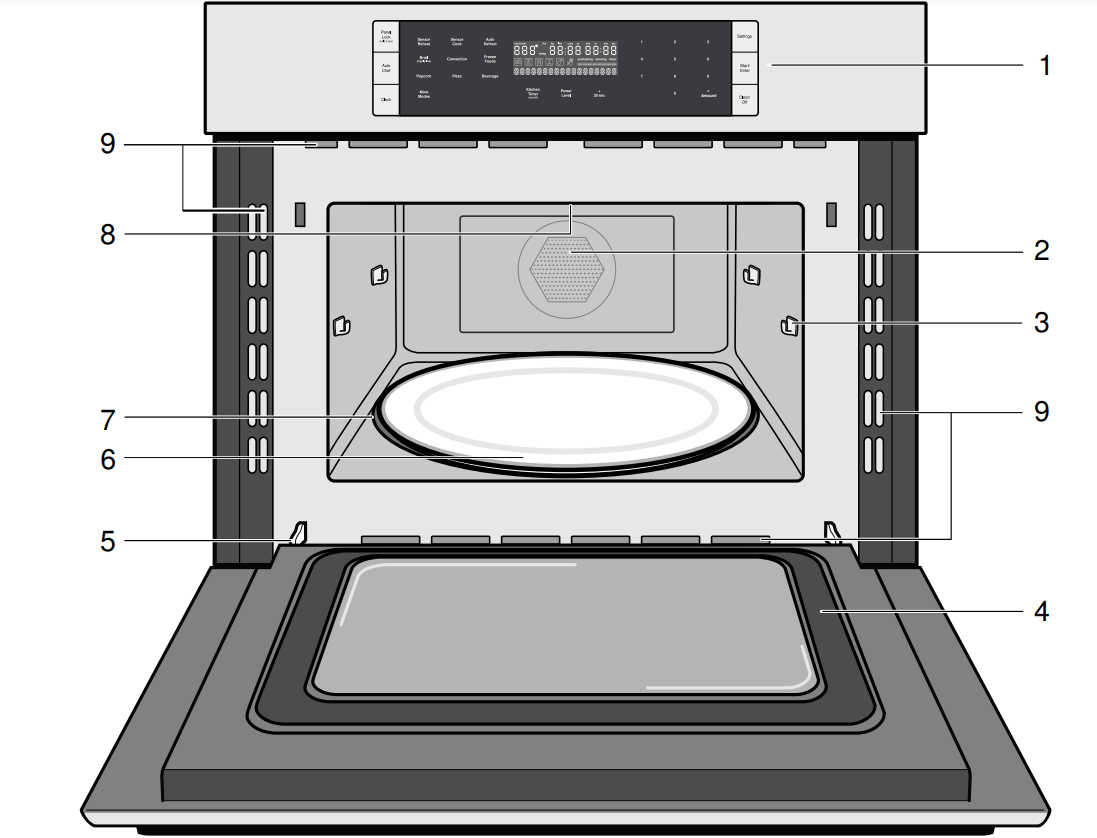
- Control panel and display
- Convection fan and element
- Rack holders (4)
- Door gasket
- Door hinges
- Ceramic microwave tray
- Metal tray turntable with bake element below
- Broil element
- Oven vents
Oven Vents
- The oven vents are located around the sides of the oven cavity. Warm air may be released from the top and bottom vents before, during and after cooking. It is normal to see steam escaping from these vents, and condensation may collect in this area. This area may be warm when the oven is in use. Do not block any vents, since they are important for air circulation.
Cooling Fan
- The cooling fan runs during all cooking modes. The fan can be heard when it is running, and warm air may be felt as it is released from the oven vents. The fan may also run after the oven is off.
Convection Fan
- The convection fan operates during all convection modes. When the oven is operating in a convection mode, the fan turns off automatically when the door is opened.
Oven light
- The oven light turns off to save energy after one minute with the door open. To turn the light back on close the door and open it again
Control panel

Touch keys
You can activate a function by briefly touching the corresponding touch key. Each time you touch a key a short beep will sound. A long beep will tell you that you have made an invalid input.
Touch key | Function |
Panel Lock | Activate/deactivate child lock |
Auto Chef | Select Auto Chef programs |
Clock | Set time of day |
Settings | Enter basic settings menu |
Start/Enter | Confirm entered values/ Start cooking mode |
Clear/Off | Clear entered value/turn appliance off |
Sensor Reheat | Select Sensor Reheat programs |
Sensor Cook | Select Sensor Cook programs |
Auto Defrost | Select Auto Defrost programs |
Broil | Set Broil modes (Hi/Lo) |
Convection | Set Convection mode |
Frozen Foods | Start cooking programs for frozen convenience foods |
Popcorn | Cook popcorn |
Pizza | Select pizza programs |
Beverage | Heat beverages |
More Modes | Enter menu for additional modes: ▯ Keep Warm ▯ Convection Broil ▯ Melt Butter ▯ Melt Chocolate ▯ Soften Ice Cream ▯ Soften Cream Cheese |
Kitchen Timer | Set the kitchen timer |
Power Level | Set power level for microwave operation |
+30 sec | Add 30 seconds to microwave cooking time |
+Amount | Can be used to browse through menu options |
| 0 - 9 | Use the number keys to enter customized values |
Display elements
The display gives you information on the current settings of your appliance. Blinking display elements indicate that an input is required.
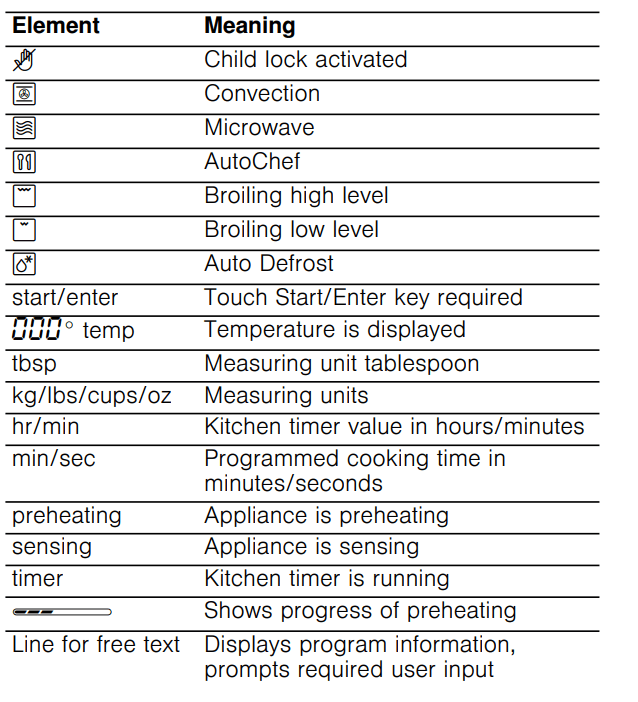
Before using the appliance for the first time
- Appliance must be properly installed by a qualified technician before use.
- Remove all packing materials from inside and outside the oven.
- While cool, wipe with a clean, damp cloth and dry.
- There may be a slight odor from your new appliance; this is normal and will disappear after a short time.
- Optimum cooking results depend on proper cookware being used.
- Read and understand all safety precautions and Use and Care Manual information.
Execute the following sections prior to operating:
Setting the clock
Once the appliance has been properly connected  will be displayed as the time of day. To set the correct time proceed as follows:
will be displayed as the time of day. To set the correct time proceed as follows:
- Touch Clock.
- Enter the correct time with the number keys. Example: To set the clock to 12:41 type in 1 2 4 1.
- Touch Start/Enter to confirm.
The clock will also be displayed when your appliance is turned off. Please refer to the chapter “Basic Settings” how to hide the clock.
Heating up the appliance
To remove the new oven smell, heat up the appliance when it is empty and closed.
One hour with Convection at 350° F (180 °C) is ideal. Ensure that no packaging remnants have been left in the oven cavity.
- Touch Convection
- Enter the numbers 3 5 0 with the number keys.
- Touch Start/Enter. The oven light turns on and the appliance starts heating.
Cleaning accessories
- Before using accessories for the first time, thoroughly clean them with hot soapy water and a soft dish cloth.
Microwave
Microwave utensil guide
Suitable ovenware
- Heat-resistant glass, glass-ceramic: Utility dishes, loaf dishes, pie plates, cake plates, liquid measuring cups, casseroles and bowls without metallic trim (e.g. Pyrex®, Anchor Hocking™, Corning Ware®, etc.).
- China: Bowls, cups, serving plates and platters without metallic trim.
- Plastic films and wraps: Plastic wrap (as a cover) - lay the plastic wrap loosely over the dish and press it to the sides. Vent plastic wrap by turning back one edge slightly to allow excess steam to escape. The dish should be deep enough so that the plastic wrap will not touch the food.
- Microwave-safe plastics: Use microwave-safe plastic dishes, cups, semi-rigid freezer containers and plastic bags for short cooking times. Use these with care because the plastic may soften from the heat of the food.
- Paper products: Paper towels, wax paper, parchment paper, paper napkins and paper plates with no metallic trim or design. Look for the manufacturers label for any special instructions for use in the microwave oven.
Unsuitable ovenware
- Metal utensils and cookware: Metal shields the food from microwave energy and produces uneven cooking. Also, avoid metal skewers, thermometers or foil trays. Metal utensils can cause arcing, which can damage your microwave oven.
- Metal decoration: Bowls, cups, serving plates and platters with metallic trim.
- Aluminum foil: Avoid large sheets of aluminum foil because they hinder cooking and may cause harmful arcing. Use small pieces of foil to shield poultry legs and wings. Keep ALL aluminum foil at least 1 inch (2.5 cm) from the side walls of the oven cavity and door of the microwave.
- Wood: Wooden bowls and boards will dry out and may split or crack when you use them in the microwave oven. Baskets made of wood will react in the same way.
- Tightly covered cookware: Be sure to leave openings for steam to escape from covered cookware. Pierce plastic pouches of vegetables or other food items before cooking. Tightly closed pouches may explode.
- Brown paper: Avoid using brown paper bags. They absorb heat and can burn.
- Flawed or chipped cooking utensils: Any utensil that is cracked, flawed or chipped may break in the oven.
- Metal twist ties: Remove metal twist ties from plastic or paper bags. They become hot and could cause a fire.
Ovenware test
Do not turn on the microwave unless there is food inside. The following ovenware test is the only exception to this rule. Perform the following test if you are unsure whether your ovenware is suitable for use in the microwave:
- Heat the empty ovenware at maximum power for ½ to 1 minute.
- Check the temperature occasionally during that time.
The ovenware should still be cold or warm to the touch. The ovenware is unsuitable if it becomes hot or sparks are generated.
Microwave power levels
You can select from 10 different microwave power levels. If you do not set a power level, the microwave will automatically operate at the highest power level 10.
The table below provides suggested power levels for various types of food that can be prepared in the microwave.
Power level | Microwave output | Use for |
 High High | 100% | Boiling water Cooking ground meat Making candy Cooking fresh fruit & vegetables Cooking fish & poultry Preheating browning dish Reheating beverages Cooking bacon slices |

| 90% | Reheating meat slices quickly Saute onions, celery & green peppers |
 | 80% | All reheating Cooking scrambled eggs |
 | 70% | Cooking breads & cereal products Cooking cheese dishes & veal Cooking muffins, brownies & cupcakes Cooking whole poultry |
 | 60% | Cooking pasta |
 | 50% | Cooking meat Cooking custard Cooking spare ribs, rib roast & sirloin roast |
 | 40% | Cooking less tender cuts of meat Reheating frozen packaged foods |
 | 30% | Thawing meat, poultry & seafood Cooking small quantities of food Finish cooking casseroles, stew & some sauces Melting chocolate |
 | 20% | Softening butter & cream cheese |
 | 10% | Softening ice cream Raise yeast dough |
Setting the microwave
The appliance must be turned off.
1. Enter the desired cook time with the number keys. The timer display will fill in from right to left. Example: To set a microwave time of 20 minutes and 30 seconds, enter the numbers 2 0 3 0. The microwave symbol  lights up and start/enter is blinking on the display
lights up and start/enter is blinking on the display

2. You can start microwave operation with the default power level 10 by touching Start/Enter, -or - you can set a different power level. Touch Power Level.  and start/enter are blinking in the upper left section of the display.
and start/enter are blinking in the upper left section of the display.

3. Enter the desired power level using the number keys. The entered power level and start/enter are blinking.
4. Touch Start/Enter to start microwave operation. The microwave timer will start to count down.
You can step up the microwave timer at any time during operation by touching +30 sec.
The appliance turns off and a beep sounds once the microwave time has run out. The appliance turns off and the clock is displayed.
Change power level
You can change the power level at any time during microwave operation.
- Touch Power Level. The display shows POWER LEVEL
 -
- 
- Enter the desired power level with the number keys. The entered power level and start/enter are blinking.
- Touch Start/Enter. Microwave operation continues with the new power level.
Opening appliance door during operation
- Opening the appliance door during operation will interrupt the current mode. Close the appliance door and then touch Start/Enter to resume operation.
+ 30 sec
- Use the +30 sec key to quick start your microwave at the highest power level. You can touch the key repeatedly to increase the microwave time in steps of 30 seconds. Touching this key during microwave operation will add 30 seconds to the remaining microwave time.
Cancel operation
- Touch Clear/Off to cancel the active oven mode. The appliance turns off and the clock is displayed. The cooling fans may continue to run for a while and then switch off automatically
Suggestions for best results
To help you achieve the best possible results from your microwave oven, read the following suggestions below:
- Storage temperature: Foods taken from the freezer or refrigerator take longer to cook than the same foods would at room temperature.
- Size: Small pieces of food cook faster than large ones. Pieces similar in size and shape will cook more evenly when cooked together. For more even results, reduce the power levels when cooking large pieces of food.
- Natural moisture: Very moist foods cook more evenly because microwave energy heats water molecules very efficiently.
- Stirring: Stir foods such as casseroles and vegetable from the outside to the center to distribute the heat more evenly. This will allow the food to cook faster. Constant stirring is not necessary.
- Turn over items: Turn over foods such as pork chops, roasts or whole cauliflower halfway through the cook time. This will help to expose all sides equally to microwave energy.
- Food placement: Place delicate areas of food items, such as asparagus tips, toward the center of the turntable tray.
- Food arrangement: Arrange unevenly shaped foods, such as chicken pieces or salmon, with the thicker or meatier parts toward the outside of the turntable tray.
- Let food stand: After removing the food from the microwave, cover the food with foil or a casserole lid and let it stand to finish cooking. This will help the food finish cooking in the center and avoids overcooking the outer edges. The length of stand time depends on the density and surface area of the food items.
- Wrapping in paper towels or wax paper: Sandwiches and many other food types containing pre-baked bread should be wrapped prior to placing in the microwave to help prevent the food items from drying out while heating.
Convection
Convection cooking circulates hot air through the oven cavity with a fan. The constantly moving air surrounds the food to heat the outer portion quickly, creating even browning and sealed-in flavor by the constant motion of hot air over the food surfaces.
You can set a temperature range from 200 to 450° F (100 to 230°C).
Notes
- Use the AutoChef mode for cooking with microwave and conventional heat combined. You can not combine these two modes manually.
- For best cooking results always use the wire rack with Convection mode.
CAUTION: The oven door and exterior and the wire rack will become hot during Convection. Always use oven mits.
Cookware tips for Convection
- Metal Pans: Recommended for all types of baked products, especially where browning is important. Dark or dull finish metal pans are best for breads and pies because they absorb heat and produce crisper crust. Shiny aluminum pans are better for cakes, cookies or muffins because they reflect heat and help produce a light tender crust.
- Glass or glass-ceramic casseroles or baking dishes: Best suited for egg and cheese recipes due to the cleanability of glass.
Note: Always use the convection rack when using the Convection mode.
Setting Convection mode
The appliance must be turned off.
1. Touch Convection. The convection symbol :  lights up. start/enter and the default temperature 325°F (160°C) are blinking on the display. The time of day will be permanently displayed during convection cooking.
lights up. start/enter and the default temperature 325°F (160°C) are blinking on the display. The time of day will be permanently displayed during convection cooking.
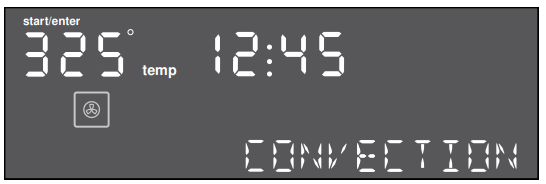
2. Change the temperature using the number keys and touch Start/Enter. The appliance starts preheating.
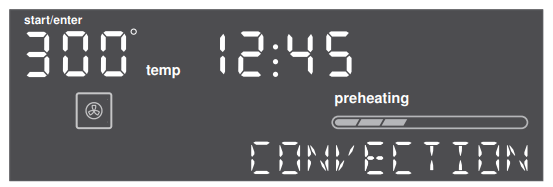
The set temperature is reached once the preheat bar has filled up completely and a beep sounds.
To change the temperature during operation, touch Convection. The temperature and start/enter begin to flash. Type in the new temperature using the number keys and confirm with Start/Enter.
Opening appliance door during operation
- Opening the appliance door during operation will interrupt the current mode. When you close the appliance door, operation will be resumed.
Cancel operation
- Touch Clear/Off to cancel the active oven mode. The appliance turns off and the clock is displayed. The cooling fans may continue to run for a while and then switch off automatically.
Broil
The Broil feature uses intense heat radiated from the upper element.
You can set two intensity levels:
- Broil high

- Broil low

Setting Broil mode
The appliance must turned off.
- Touch Broil. The Broil mode is set to high.
 ‚ and start/enter are blinking, the Broil high symbol
‚ and start/enter are blinking, the Broil high symbol  will be displayed. The time of day will be permanently displayed in Broil mode.
will be displayed. The time of day will be permanently displayed in Broil mode. 
- Touch Broil again or use the +Amount key, to change to Broil low mode.
 and the broil low symbol
and the broil low symbol  will light up on the display.
will light up on the display. - Touch Start/Enter to start operation.
You can alternate between Broil high and Broil low during operation by touching either Broil or +Amount.
Note: Always use a broil pan when cooking in Broil mode (see optional accessories).
Opening appliance door during operation
- Opening the appliance door during operation will interrupt the current mode. When you close the appliance door, operation will be resumed.
Cancel operation
- Touch Clear/Off to cancel the active oven mode. The appliance turns off and the clock is displayed. The cooling fans may continue to run for a while and then switch off automatically.
Cleaning and Maintenance
WARNING: Be sure the entire appliance has cooled and grease has solidified before attempting to clean any part of the appliance.
Cleaning Guide
- For best performance and for safety reasons, keep the oven clean inside and outside. Take special care to keep the inner door panel and oven front frame free of food and grease build–up.
- Never use abrasive scouring powder or pads on the microwave. Wipe the microwave oven inside and out with a soft cloth and warm (not hot) mild detergent solution. Then rinse and wipe completely dry.
- Wipe spatters immediately with a wet paper towel, especially after cooking greasy foods like chicken or bacon.
- Clean your microwave oven weekly or more often, if needed.
- Never operate the microwave oven without food in the oven cavity, unless pre-heating with Convection, Pizza, Frozen Foods and Keep Warm mode; this can damage the magnetron tube or ceramic tray. You may wish to leave a cup of water standing inside the oven when it is not in use to prevent damage if the oven is accidentally turned on.
Part | Recommendations |
| Oven cavity | Keep inside (cavity) of the oven clean. Food particles and spilled liquids can stick to the oven walls, causing the oven to work less efficiently. Wipe up spills immediately. Use a damp, clean cloth and mild soap. DO NOT use harsh detergents or abrasive cleaners. To help loosen baked–on food particles or liquids, heat 2 cups of water (add the juice of 1 lemon if you desire to keep the oven fresh smelling) in a 4 cup measuring glass at High power for 5 minutes or until boiling. Let stand in oven cavity for 1 or 2 minutes. For baked-on grease spatters, wash with hot, soapy water, rinse and dry |
| Wire rack | Wash with soapy water. Rinse thoroughly and dry, or gently rub with cleansing powder or soap-filled pads as directed. The wire rack can also be washed in the dishwasher. |
| Metal turntable tray | Remove metal turntable tray from the oven when cleaning the oven cavity and tray. Wash the metal turntable tray in warm sudsy water or in the dishwasher. |
| Ceramic tray | Clean with warm, soapy water or in the dishwasher. |
| Door seal | Wipe with damp cloth. |
| Door glass | Wash with soap and water or glass cleaner. Use Fantastik® or Formula 409® to a clean sponge or paper towel and wipe clean. Avoid using powder cleaning agents, steel wool pads and oven cleaners. If steam accumulates inside or outside the oven door, wipe with a soft cloth. Steam can accumulate when operating the oven in high humidity and in no way indicates microwave leakage. |
| Painted surfaces | Clean with hot soapy water or apply Fantastik® or Formula 409® to a clean sponge or paper towel and wipe clean. Avoid using powder cleaning agents, steel wool pads and oven cleaners. |
| Stainless steel surfaces/ exterior surfaces | Always wipe or rub in the direction of the grain. Clean with a soapy sponge, then rinse and dry, or wipe with Fantastik® or Formula 409® spray on a paper towel. Protect and polish with Stainless Steel Magic® and a soft cloth. Remove water spots with a cloth dampened with white vinegar |
| Plastic & Controls | When cool, clean with soapy water, rinse and dry |
| Printed areas (words & numbers) | Do not use abrasive cleaners or petroleum based solvents. |
Troubleshooting
If you encounter a problem, it often will merely be something minor. Before you call customer service, consider the suggestions and instructions below:
Problem | Suggestion |
| Neither the microwave’s display nor oven operates. |
|
| The oven display works, but the oven will not operate. |
|
| The power goes off before the cook time has elapsed. |
|
The microwave power level switches from power level  to power level to power level  | If the oven is set to cook for more than 30 minutes at 100% power level, it will automatically reduce the power to a 80% power level after 30 minutes to avoid overcooking. |
| You see sparks or arcing | Remove any metallic utensils, cookware or metal ties from the oven cavity. If using aluminum foil, use only narrow strips and allow at least one inch between the foil and the interior oven walls. |
| The turntable makes noises or sticks. |
|
| Using your microwave causes TV or radio interference. | This is similar to the interference caused by other small appliances, such as hair dryers. Move your microwave further away from other appliances, like your TV or radio. |
| Error codes | Note any error codes that may appear on the dispay. They may be helpful for the service technician. |
| E-01 | Thermistor error (open) |
| E-04 | Thermistor error (short) |
| E-08 | Humidity sensor error |
| E-11 | Key pressed for more than 10 seconds or condensation on keypad |
| E-17 | Pre-heat too long |
See other models: SHXM78W55N/01 SHV65P03UC/63 B36BT830NS/07 SHE3ARF2UC/07 B22CS30SNS/01
